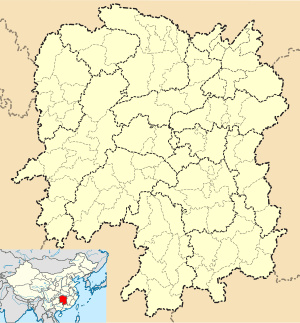Fenghuang County
| Fenghuang County 凤凰县 | |
|---|---|
| County | |
|
| |
 Fenghuang Location in Hunan | |
| Coordinates: 27°56′56″N 109°36′14″E / 27.949°N 109.604°ECoordinates: 27°56′56″N 109°36′14″E / 27.949°N 109.604°E[1] | |
| Country | People's Republic of China |
| Province | Hunan |
| Autonomous prefecture | Xiangxi |
| Area[2] | |
| • Total | 1,751.10 km2 (676.10 sq mi) |
| Population (2010)[3] | |
| • Total | 350,195 |
| • Density | 200/km2 (520/sq mi) |
| Time zone | China Standard (UTC+8) |
| Postal code | 4162XX |
Fenghuang County (simplified Chinese: 凤凰县; traditional Chinese: 鳳凰縣; pinyin: Fènghuáng Xiàn; literally: "phoenix county") is under the administration of Xiangxi Tujia and Miao Autonomous Prefecture, Hunan province, China, bordering the prefecture-level cities of Huaihua to the southeast and Tongren (Guizhou) to the west. It has an exceptionally well-preserved ancient town that harbors unique ethnic languages, customs, arts as well as many distinctive architectural remains of Ming and Qing styles. The town is placed in a mountain setting, incorporating the natural flow of water into city layout.[4] Over half of the city's population belong to the Miao or Tujia minorities.[5] It was the center of the unsuccessful Miao Rebellion (1854–73), which created a Miao diaspora in Southeast Asia during the last two centuries. The city is revered in Miao traditions and funeral rites and is the location of the Southern China Great Wall (中国南方长城; 中國南方長城; Zhōngguó Nánfāng Chángchéng; Miao: "Suav Tuam Choj"), a fortification built by the Ming dynasty to protect the local Han Chinese from Miao attacks.
History

After 1913, the name of the town changed from Zhen'gan (鎮筸) to Fenghuang.[6]
The town was damaged by flooding in July 2014.[7]
World Heritage status

The ancient town of Fenghuang was added to the UNESCO World Heritage Tentative List on March 28, 2008 in the Cultural category. This ancient town was regarded as the most beautiful town in China by New Zealand writer Rewi Alley. It was built in 1704, and has 300 years of history. The ancient city is a gathering place for Miao and Tujia ethnic minorities.
Notable People
- Shen Congwen - modern author and researcher of Chinese material arts. His childhood home is a popular tourist attraction in Fenghuang town.
- Huang Yongyu - painter
Transportation
Though there is no airport or train station in Fenghuang County, it is quite convenient to go to Fenghuang. The nearest airport Fenghuang Airport in Tongren City is only 34km away from Fenghuang County and the nearest train station in Jishou City is only 50km away. After arriving at Fenghuang Airport or Jishou Train Station, tourists may take a bus or taxi to Fenghuang County. Zhangjiajie Airport and Huaihua Train Station are also often used as transfer stops for Fenghuang County. [8][9]
Notes
- ↑ Google (2014-07-02). "Fenghuang" (Map). Google Maps. Google. Retrieved 2014-07-02.
- ↑ Xiangxi Tujia and Miao Autonomous Prefecture Land Use Plan (2006–20)/《湘西土家族苗族自治州土地利用总体规划(2006-2020年)》.(Chinese) Accessed 8 July 2014.
- ↑ 湘西自治州2010年第六次全国人口普查主要数据公报 (in Chinese). Xiangxi Prefecture People's Government. Retrieved 9 July 2014.
- ↑ Fenghuang Ancient City - UNESCO World Heritage Centre
- ↑ Wang (2007) p 135
- ↑ Kinkley, Jeffrey C. (1987). The Odyssey of Shen Congwen. Stanford University Press. p. 19.
- ↑ Ancient town under water as downpour hit central China
- ↑ "Fenghuang County" ChinaTour.Net Accessed 2014-9-25
- ↑ "Фэнхуан | Fenghuang". zhangjiajie-wulingyuan.ru. Retrieved 2016-04-21.
References
- Fenghuang Ancient City - UNESCO World Heritage Centre Accessed 2009-02-25.
- Wang, Y., et al. (2007),Brand in China, 五洲传播出版社. ISBN 7-5085-1086-0
External links
| Wikivoyage has a travel guide for Fenghuang. |
| Wikimedia Commons has media related to Fenghuang County. |
